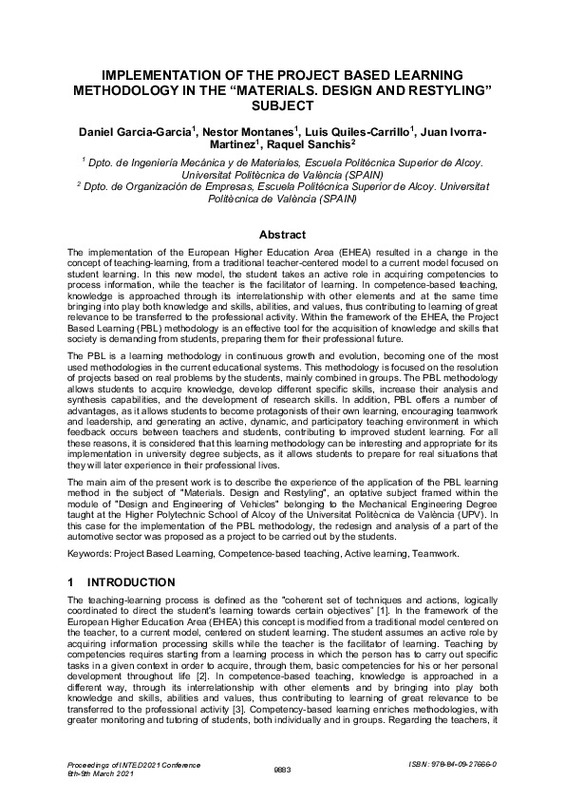|
Resumen:
|
[EN] The implementation of the European Higher Education Area (EHEA) resulted in a change in the
concept of teaching-learning, from a traditional teacher-centered model to a current model focused on
student learning. In ...[+]
[EN] The implementation of the European Higher Education Area (EHEA) resulted in a change in the
concept of teaching-learning, from a traditional teacher-centered model to a current model focused on
student learning. In this new model, the student takes an active role in acquiring competencies to
process information, while the teacher is the facilitator of learning. In competence-based teaching,
knowledge is approached through its interrelationship with other elements and at the same time
bringing into play both knowledge and skills, abilities, and values, thus contributing to learning of great
relevance to be transferred to the professional activity. Within the framework of the EHEA, the Project
Based Learning (PBL) methodology is an effective tool for the acquisition of knowledge and skills that
society is demanding from students, preparing them for their professional future.
The PBL is a learning methodology in continuous growth and evolution, becoming one of the most
used methodologies in the current educational systems. This methodology is focused on the resolution
of projects based on real problems by the students, mainly combined in groups. The PBL methodology
allows students to acquire knowledge, develop different specific skills, increase their analysis and
synthesis capabilities, and the development of research skills. In addition, PBL offers a number of
advantages, as it allows students to become protagonists of their own learning, encouraging teamwork
and leadership, and generating an active, dynamic, and participatory teaching environment in which
feedback occurs between teachers and students, contributing to improved student learning. For all
these reasons, it is considered that this learning methodology can be interesting and appropriate for its
implementation in university degree subjects, as it allows students to prepare for real situations that
they will later experience in their professional lives.
The main aim of the present work is to describe the experience of the application of the PBL learning
method in the subject of "Materials. Design and Restyling", an optative subject framed within the
module of "Design and Engineering of Vehicles" belonging to the Mechanical Engineering Degree
taught at the Higher Polytechnic School of Alcoy of the Universitat Politècnica de València (UPV). In
this case for the implementation of the PBL methodology, the redesign and analysis of a part of the
automotive sector was proposed as a project to be carried out by the students.
[-]
|
|
Agradecimientos:
|
This article has been supported by Universitat Politècnica de València, particularly by the Vicerectorate for Digital Resources and Documentation (Vicerrectorado de Recursos Digitales y
Documentación) and Vice-Rectorate ...[+]
This article has been supported by Universitat Politècnica de València, particularly by the Vicerectorate for Digital Resources and Documentation (Vicerrectorado de Recursos Digitales y
Documentación) and Vice-Rectorate for Studies, Quality and Accreditation (Vicerrectorado de
Estudios, Calidad y Acreditación) under the Call for Learning + Teaching (Convocatoria A+D2019:
Aprendizaje + Docencia. Proyectos de Innovación y Mejora Educativa) and Project Code: A157. The
authors would like to acknowledge the support of the Institute of Educational Sciences (Instituto de
Ciencias de la Educación), the Evaluation and Monitoring Commission for Educational Innovation and
Improvement Projects (Comisión de Evaluación y Seguimiento de Proyectos de Innovación y Mejora
Educativa (CESPIME) and Escuela Politécnica Superior de Alcoy.
[-]
|









